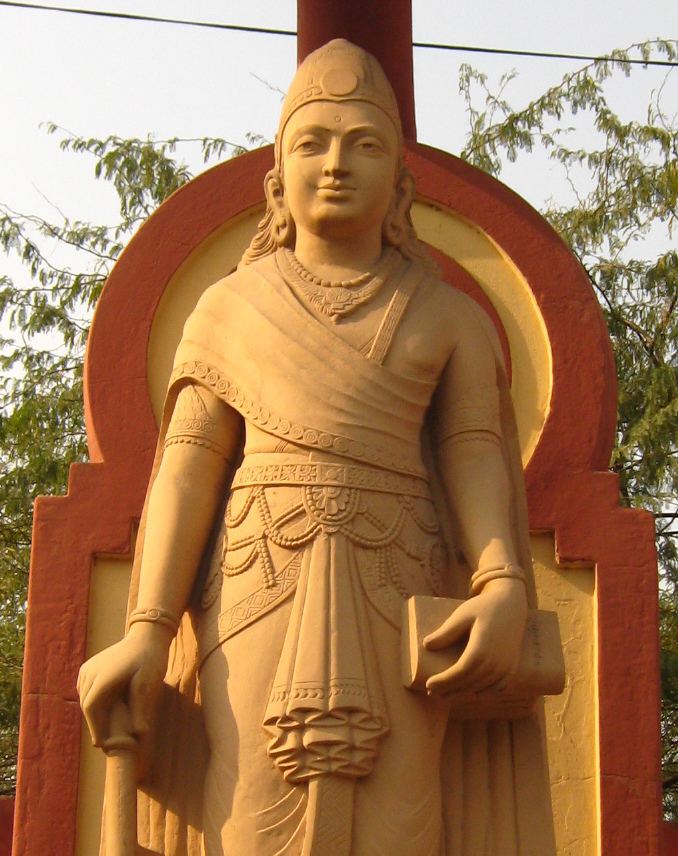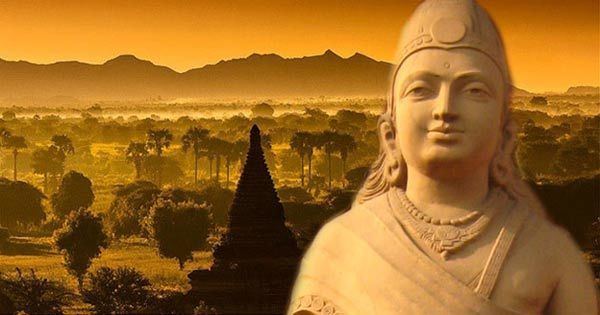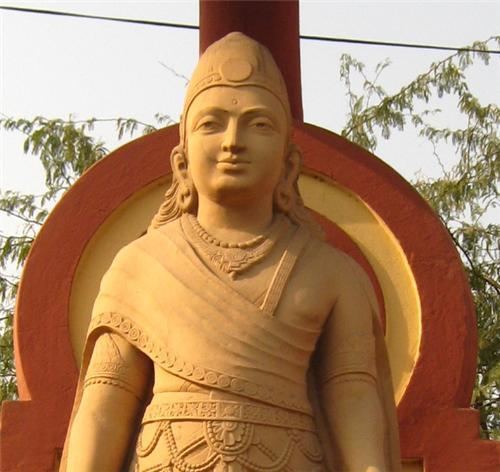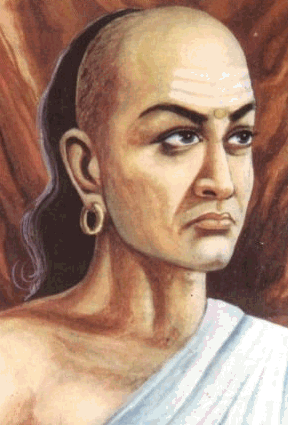Reign c. 324 – c. 297 BCE Dynasty Maurya Greek Sandrocottus | Children Bindusara | |
 | ||
Parents Mura Maurya, Sarvarthasiddhi Maurya Similar People | ||
Chandragupta maurya the mauryan empire history chanakya niti education video
Chandragupta Maurya (reign: 321–298 BCE) was the founder of the Maurya Empire in ancient India. He was born in a humble family, orphaned and abandoned, raised as a son by another pastoral family, then according to Buddhist texts, was picked up, taught and counselled by Chanakya, the author of the Arthashastra. Chandragupta thereafter built one of the largest empires ever in the Indian subcontinent. According to Jain sources, he then renounced it all, and became a monk in the Jain tradition. Chandragupta is claimed, by the historic Jain texts, to have followed Jainism in his life, by first renouncing all his wealth and power, going away with Jaina monks into the Deccan region (now Karnataka), and ultimately performing Sallekhana – the Jain religious ritual of peacefully welcoming death by fasting. His grandson was emperor Ashoka, famous for his historic pillars and for his role in helping spread Buddhism outside of ancient India. Chandragupta's life and accomplishments are described in ancient Hindu, Buddhist and Greek texts, but they vary significantly in details from the Jaina accounts. Megasthenes served as a Greek ambassador in his court for four years. In Greek and Latin accounts, Chandragupta is known as Sandrokottos and Androcottus.
Contents
- Chandragupta maurya the mauryan empire history chanakya niti education video
- Nhd documentary chandragupta maurya
- Early life
- Building the Empire
- Eastward expansion and the end of Nanda empire
- Conquest of northwest regions
- War and marriage alliance with Seleucus
- Southern conquest
- Army
- Rule succession and death
- Infrastructure projects
- Arts and architecture
- Succession
- Death
- In popular culture
- References

Chandragupta Maurya was a pivotal figure in the history of India. Prior to his consolidation of power, Alexander the Great had invaded the northwest Indian subcontinent, then abandoned further campaigning in 324 BCE, leaving a legacy of Indian subcontinental regions ruled by Indo-Greek and local rulers. The region was divided into Mahajanapadas, while the Nanda Empire dominated the Indo-Gangetic Plain. Chandragupta, with the counsel of his Chief Minister Chanakya (the Brahmin also known as Kautilya), created a new empire, applied the principles of statecraft, built a large army and continued expanding the boundaries of his empire. Greek rulers such as Seleucus I Nicator avoided war with him, entered into marriage alliances instead, and retreated into Persia. Chandragupta's empire extended from Bengal to most of the Indian subcontinent, except the southernmost regions (now Tamil Nadu, Kerala and nearby) and Kalinga (now Odisha region). It was the largest ancient empire documented in Indian history.

After unifying much of India, Chandragupta and Chanakya passed a series of major economic and political reforms. He established a strong central administration from Pataliputra (now Patna), patterned after Chanakya's text on governance and politics, the Arthashastra. Chandragupta's India was characterised by an efficient and highly organised structure. The empire built infrastructure such as irrigation, temples, mines and roads, leading to a strong economy. With internal and external trade thriving and agriculture flourishing, the empire built a large and trained permanent army to help expand and protect its boundaries. Greek records suggest that art and city architecture thrived during his rule. Chandragupta's reign, as well the dynasty that followed him, was an era when many religions thrived in India, with Buddhism, Jainism and Ajivika gaining prominence along with the Brahmanism traditions.

Nhd documentary chandragupta maurya
Early life

Chandragupta's ancestry, birth year and family as well as early life are unclear. This contrasts with abundant historical records, both in Indian and classical European sources, that describe his reign and empire. The Greek and Latin literature phonetically transcribes Chandragupta, referring to him with the names "Sandrokottos" or "Androcottus". According to Radhakumud Mookerji
According to Kaushik Roy, both Chandragupta Maurya and the Nanda dynasty he replaced were of Shudra lineage. After his birth, he was orphaned and abandoned, raised as a son by a cowherding pastoral family, then, according to Buddhist texts, was picked up, taught and counselled by Chanakya. The Buddhist literature, which places the Mauryas in the same royal dynasty as the Buddha, states that Chandragupta, though born near Patna (Bihar) in Magadha, was taken by Chanakya for his training and education to Taxila, a town in what is now northern Pakistan. There he studied for eight years. The Greek and Hindu texts state that Kautilya (Chanakya) was a native of the northwest Indian subcontinent, and Chandragupta was his resident student for eight years.
Building the Empire
According to the Buddhist text Mahavamsa tika, Chandragupta and his guru Chanakya began recruiting an army after he completed his studies at Taxila (now in Pakistan). This was a period of wars, given that Alexander the Great had invaded the northwest subcontinent from Caucasus Indicus (also called Paropamisadae in ancient texts, now called the Hindu Kush mountain range). Alexander and the Greeks abandoned further campaigns of expansion in 324 BCE, and began a retreat to Greece, leaving a legacy of Indian subcontinent regions ruled by new Greek governors and local rulers. A supply of warriors was already in place, and the future emperor and his teacher chose to build alliances with local rulers and a small mercenary army of their own. Chanakya also identified talent for future administration. By 323 BCE, within a year of Alexander's retreat, this newly formed group had defeated some of the Greek-ruled cities in the northwest subcontinent. Each victory led to an expanded army and territory. Chanakya provided the strategy, Chandragupta the execution, and together they began expanding eastward towards Magadha (Gangetic plains).
Eastward expansion and the end of Nanda empire
Historically reliable details of Chandragupta's campaign into Pataliputra are unavailable; the legends written centuries later are inconsistent. According to Buddhist texts such as Milindapanha, which state Chandragupta descended from Sakyas (the family of the Buddha), Magadha was ruled by the evil Nanda dynasty, which Chandragupta, with Chanakya's counsel, easily conquered to restore dhamma. In contrast, Hindu and Jain records suggest that campaign was bitterly fought, because the Nanda dynasty had a well trained, powerful army. Chandragupta and Chanakya built alliances and a formidable army of their own first.
The Mudrarakshasa of Vishakhadatta as well as the Jain work Parishishtaparvan, for example, state that Chandragupta allied with a Himalayan king called Parvatka. It is noted in the Chandraguptakatha that Chandragupta and Chanakya were initially rebuffed by the Nanda forces. Regardless, in the ensuing war, Chandragupta faced off against Bhadrasala, the commander of Dhana Nanda's armies. He was eventually able to defeat Bhadrasala and Dhana Nanda in a series of battles, culminating in the siege of the capital city Pataliputra and the conquest of the Nanda Empire around 322 BCE. With the end of the Nanda dynasty, and possessing the resources of the Gangetic plains, Chandragupta put to work the statecraft strategies of Chanakya. In his efforts to expand and consolidate an empire, Chandragupta may have allied with the King of Simhapura in Rajputana and Gajapati, King of Kalinga (modern day Orissa).
The conquest was fictionalised in Mudrarakshasa, a political drama in Sanskrit by Vishakadatta composed 600 years later, probably sometime between 300 CE and 700 CE. In another work, Questions of Milinda, Bhaddasala is named as a Nanda general during the conquest. Plutarch does not discuss this conquest, but does estimate that Chandragupta's army would later number 600,000 by the time it had subdued all of India, an estimate also given by Pliny. Pliny and Plutarch also estimated the Nanda Army strength in the east as 200,000 infantry, 80,000 cavalry, 8,000 chariots, and 6,000 war elephants. These estimates were based in part of the earlier work of the Seleucid ambassador to the Maurya, Megasthenes.
In the fictional work of doubtful historicity Mudrarakshasa, Chandragupta was said to have first acquired Punjab, and then combined forces with a local king named Parvatka under the advice of Chanakya, and advanced upon the Nanda Empire. Chandragupta laid siege to Kusumapura (or Pataliputra, now Patna), the capital of Magadha, with the help of mercenaries from areas already conquered and by deploying guerrilla warfare methods. P. K. Bhattacharyya states that the empire was built by a gradual conquest of provinces after the initial consolidation of Magadha.
Conquest of northwest regions
After Alexander's death in 323 BCE, Chandragupta and his Brahmin counsellor and chief minister Chanakya began their empire building in the north-western Indian subcontinent (modern-day Pakistan). Alexander had left satrapies (described as "prefects" in classical Western sources) in place in 324 BCE. Chandragupta's mercernaries may have assassinated two of his governors, Nicanor and Philip. The satrapies he fought probably included Eudemus, who left the territory in 317 BCE; and Peithon, governing cities near the Indus River until he too left for Babylon in 316 BCE. The Roman historian Justin, about 500 years later, described how "wild lions and elephants" instinctively revered him, and how he conquered the north-west:
While he (Sandrocottus [Chandragupta]) was lying asleep, after his fatigue, a lion of great size having come up to him, licked off with his tongue the sweat that was running from him, and after gently waking him, left him. Being first prompted by this prodigy to conceive hopes of royal dignity, he drew together a band of robbers, and solicited the Indians to support his new sovereignty. Some time after, as he was going to war with the generals of Alexander, a wild elephant of great bulk presented itself before him of its own accord, and, as if tamed down to gentleness, took him on its back, and became his guide in the war, and conspicuous in fields of battle. Sandrocottus, having thus acquired a throne, was in possession of India, when Seleucus was laying the foundations of his future greatness; who, after making a league with him, and settling his affairs in the east, proceeded to join in the war against Antigonus. As soon as the forces, therefore, of all the confederates were united, a battle was fought, in which Antigonus was slain, and his son Demetrius put to flight.
War and marriage alliance with Seleucus
Seleucus I Nicator, a Macedonian general of Alexander, who, in 312 BCE, established the Seleucid Kingdom with its capital at Babylon, reconquered most of Alexander's former empire in Asia and put under his own authority the eastern territories as far as Bactria and the Indus (Appian, History of Rome, The Syrian Wars 55), and in 305 BCE he entered into conflict with Chandragupta (in Greek Sandrocottus):
Always lying in wait for the neighboring nations, strong in arms and persuasive in council, he acquired Mesopotamia, Armenia, 'Seleucid' Cappadocia, Persis, Parthia, Bactria, Arabia, Tapuria, Sogdia, Arachosia, Hyrcania, and other adjacent peoples that had been subdued by Alexander, as far as the river Indus, so that the boundaries of his empire were the most extensive in Asia after that of Alexander. The whole region from Phrygia to the Indus was subject to Seleucus. He crossed the Indus and waged war with Sandrocottus [Maurya], king of the Indians, who dwelt on the banks of that stream, until they came to an understanding with each other and contracted a marriage relationship. Some of these exploits were performed before the death of Antigonus and some afterward.
According to R. C. Majumdar and D. D. Kosambi, Seleucus appears to have fared poorly, having ceded large territories west of the Indus to Chandragupta. The Maurya Empire added Arachosia (modern Kandahar), Gedrosia (modern Balochistan), Paropamisadae (or Gandhara).
According to Strabo, Chandragupta engaged in a marital alliance with Seleucus to formalise the peace treaty:
The Indians occupy in part some of the countries situated along the Indus, which formerly belonged to the Persians: Alexander deprived the Ariani of them, and established there settlements of his own. But Seleucus Nicator gave them to Sandrocottus in consequence of a marriage contract (Epigamia, Greek: Ἐπιγαμία), and received in return five hundred elephants.
The details of the engagement treaty are not known, but since the extensive sources available on Seleucus never mention an Indian princess, it is thought that the marital alliance went the other way, with Chandragupta himself or his son Bindusara marrying a Seleucid princess, in accordance with contemporary Greek practices to form dynastic alliances. An Indian Puranic source, the Pratisarga Parva of the Bhavishya Purana, described the marriage of Chandragupta with a Greek ("Yavana") princess, daughter of Seleucus, before accurately detailing early Mauryan genealogy:
"Chandragupta married with a daughter of Suluva, the Yavana king of Pausasa. Thus, he mixed the Buddhists and the Yavanas. He ruled for 60 years. From him, Vindusara was born and ruled for the same number of years as his father. His son was Ashoka."
In a return gesture, Chandragupta sent 500 war elephants, which played a key role in the victory of Seleucus at the Battle of Ipsus. In addition to this treaty, Seleucus dispatched an ambassador, Megasthenes, to Chandragupta, and later Antiochos sent Deimakos to his son Bindusara, at the Maurya court at Pataliputra (modern Patna in Bihar state).
According to Greek sources, the two rulers maintained friendly relations and presents continued to be exchanged between them. Classical sources have recorded that following their treaty, Chandragupta and Seleucus exchanged presents, such as when Chandragupta sent various aphrodisiacs to Seleucus:
"And Theophrastus says that some contrivances are of wondrous efficacy in such matters as to make people more amorous. And Phylarchus confirms him, by reference to some of the presents which Sandrakottus, the king of the Indians, sent to Seleucus; which were to act like charms in producing a wonderful degree of affection, while some, on the contrary, were to banish love" Athenaeus of Naucratis, "The deipnosophists" Book I, chapter 32
Southern conquest
After annexing Seleucus' provinces west of the Indus river, Chandragupta had a vast empire extending across the northern parts of the Indian Sub-continent, from the Bay of Bengal to the Arabian Sea. Chandragupta then began expanding his empire further south beyond the barrier of the Vindhya Range and into the Deccan Plateau. By the time his conquests were complete, Chandragupta's empire extended over most of the Indian subcontinent.
A "Moriya" war in south is referred three times in the Tamil work Ahananuru, and once in Purananuru. These mention how Moriya army chariots cut through rocks, but it is unclear if this refers to Chandragupta Maurya or the Moriyas in the Deccan region of the 5th century CE.
Army
Chandragupta's army was large, well trained and paid directly by the state as suggested by his counsellor Chanakya. It was estimated at hundreds of thousands of soliders in Greek accounts. For example, his army is mentioned to have 400,000 soldiers, according to Strabo:
Megasthenes was in the camp of Sandrocottus, which consisted of 400,000 men.
Pliny the Elder, who also drew from Megasthenes' work, gives even larger numbers of 600,000 infantry, 30,000 cavalry, and 9,000 war elephants. Mudrarakshasa mentions that Chandragupta's army consisted of Sakas, Yavanas (Greeks), Kiratas, Kambojas, Parasikas and Bahlikas.
Rule, succession and death
Chandragupta Maurya applied the statecraft and economic policies described in Chanakya's Arthashastra. There are varying accounts in the historic, legendary and hagiographic literature of various Indian religions about Chandragupta, but these claims, state Allchin and Erdosy, are suspect. They add that the evidence is, however, not limited to texts, but include those discovered at archeological sites, epigraphy in the centuries that followed and the numismatic data, and "one cannot but be struck by the many close correspondences between the (Hindu) Arthashastra and the two other major sources the (Buddhist) Asokan inscriptions and (Greek) Megasthenes text".
The Maurya rule was a structured administration, where Chandragupta had a council of ministers (amatya), the empire was organized into territories (janapada), centers of regional power were protected with forts (durga), state operations funded with treasury (kosa).
Infrastructure projects
Ancient epigraphical evidence suggests that Chandragupta Maurya, under counsel from Chanakya, started and completed many irrigation reservoirs and networks across the Indian subcontinent in order to ensure food supplies for civilian population and the army, a practice continued by his dynastic successors. Regional prosperity in agriculture was one of the required duties of his state officials. Rudradaman inscriptions found in Gujarat mention that it repaired and enlarged, 400 years later, the irrigation infrastructure built by Chandragupta and enhanced by Asoka.
Chandragupta's state also started mines, centers to produce goods, and networks for trading these goods. His rule developed land routes for goods transportation within the Indian subcontinent, disfavoring water transport. Chandragupta expanded "roads suitable for carts", preferring these over those narrow tracts that allowed only pack animals.
According to Kaushik Roy, the Maurya dynasty rulers, beginning with Chandragupta, were "great road builders". This was a tradition the Greek ambassador Megasthenes credited to Chandragupta with the completion of a thousand-mile-long highway connecting Chandragupta's capital Pataliputra in Bihar to Taxila in the northwest where he studied. The other major strategic road infrastructure credited to this tradition spread from Pataliputra in various directions: one connecting it to Nepal, Kapilavastu, Kalsi (now Dehradun), Sasaram (now Mirzapur), Kalinga (now Odisha), Andhra and Karnataka. This infrastructure not only boosted trade and commerce, states Roy, but also helped move his armies rapidly and more efficiently than ever before.
Chandragupta and his counsel Chanakya seeded weapon manufacturing centers, and kept it a monopoly of the state. However, the state encouraged competing private parties to operate mines and supply these centers. They considered economic prosperity as essential to the pursuit of dharma (morality), adopting a policy of avoiding war with diplomacy, yet continuously preparing the army for war to defend its interests, and other ideas in the Arthashastra.
Arts and architecture
The evidence of arts and architecture during Chandragupta's time is limited, predominantly texts such as those by Megasthenes and Kautilya's Arthashastra. The edict inscriptions and carvings on monumental pillars are attributed to his grandson Ashoka. The texts imply cities, public works and prosperous architecture, but the historicity of these is in question.
Archeological discoveries in the modern age, such as Didarganj Yakshi discovered in 1917 buried beneath the banks of the River Ganges suggest exceptional artisanal accomplishment. It has been dated to the 3rd century BCE by many scholars, but later dates such as 2nd century BCE or the Kushan era (1st-4th century CE) have also been proposed. The competing theories are that the arts linked to Chandragupta Maurya's dynasty was learnt from the Greeks and West Asia in the years Alexander the Great waged war, while the other credits more ancient indigenous Indian tradition. According to Frederick Asher, "we cannot pretend to have definitive answers; and perhaps, as with most art, we must recognize that there is no single answer or explanation".
Succession
After Chandragupta's renunciation, his son Bindusara succeeded as the Maurya Emperor. He maintained friendly relations with Greek governors in Asia and Egypt. Bindusara's son Ashoka became one of the most influential rulers in India's history due to his extension of the Empire to the entire Indian subcontinent as well as his role in the worldwide propagation of Buddhism.
Death
According to Jain accounts written more than 1,000 years later, such as those in Brihakathā kośa (931 CE) of Harishena, Bhadrabāhu charita (1450 CE) of Ratnanandi, Munivaṃsa bhyudaya (1680 CE) and Rajavali kathe, Chandragupta renounced his throne and followed Jain teacher Bhadrabahu to south India. He is said to have lived as an ascetic at Shravanabelagola for several years before fasting to death, as per the Jain practice of sallekhana.
Along with texts, several Jain monumental inscriptions dating from the 7th-15th century refer to Bhadrabahu and Chandragupta in conjunction. This evidence is very late and anachronistic, and questionable in its historicity, but suggests the importance of Chandragupta Maurya in Jain culture. The hill on which Chandragupta is stated in Jain tradition to have performed asceticism is now known as Chandragiri hill, and there is a temple named Chandragupta basadi there.
The Hindu texts acknowledge the close relationship between the Jain community in Pataliputra and the royal court, and that the champion of Brahmanism Chanakya himself employed Jains as his emissaries. This indirectly confirms the possible influence of Jain thought on Chandragupta.
According to Kaushik Roy, Chandragupta renounced his wealth and power, crowned his son as his successor about 298 BCE, and died about 297 BCE.
